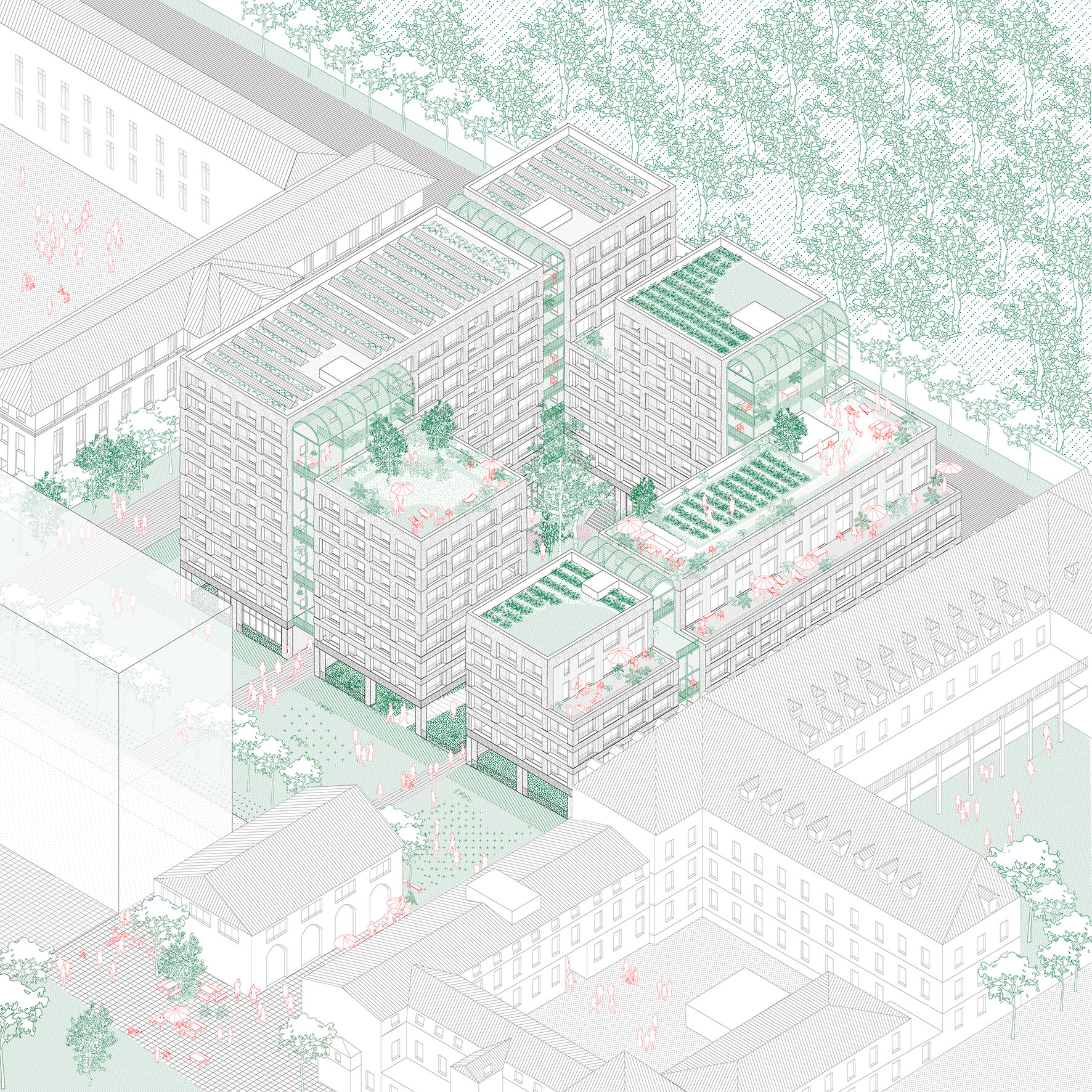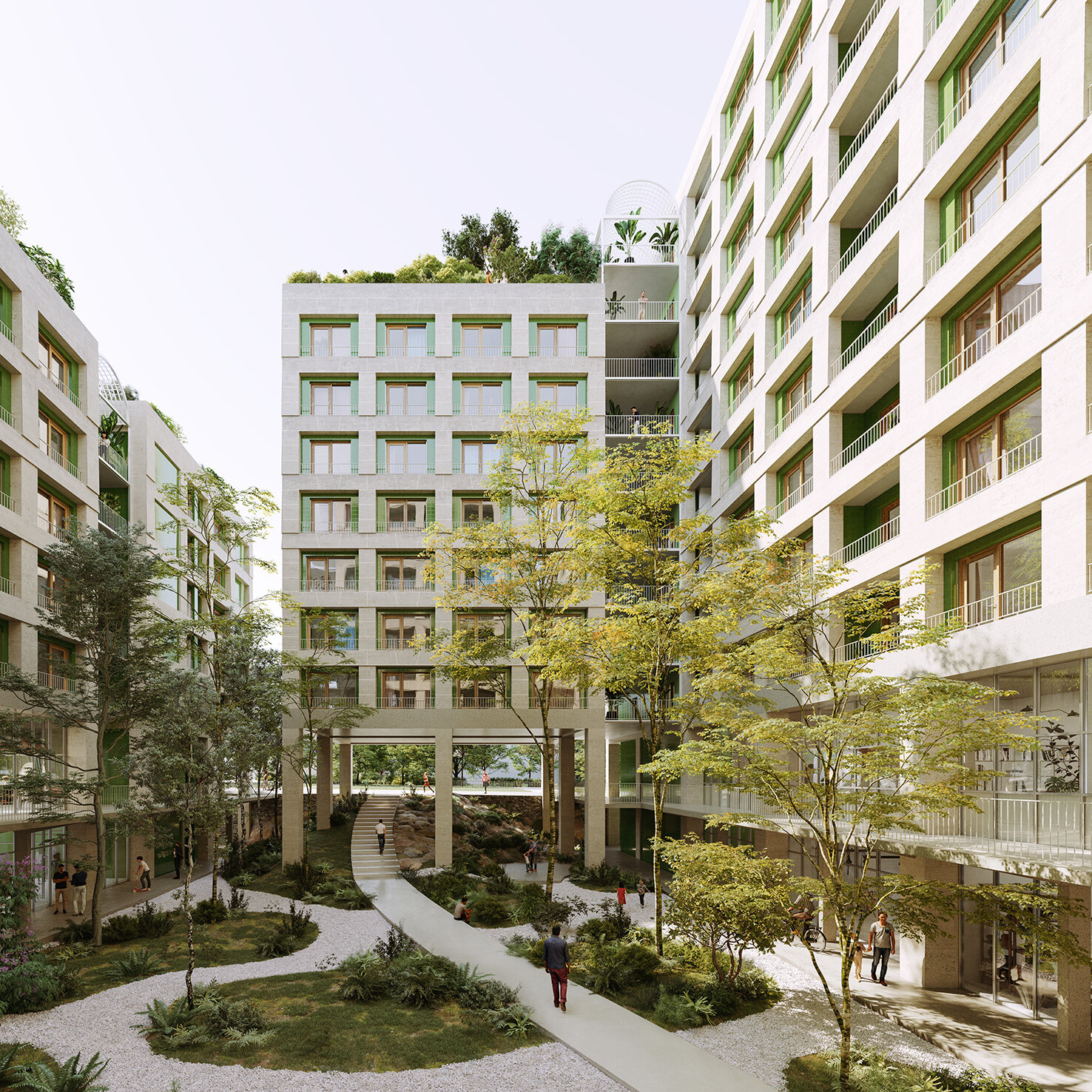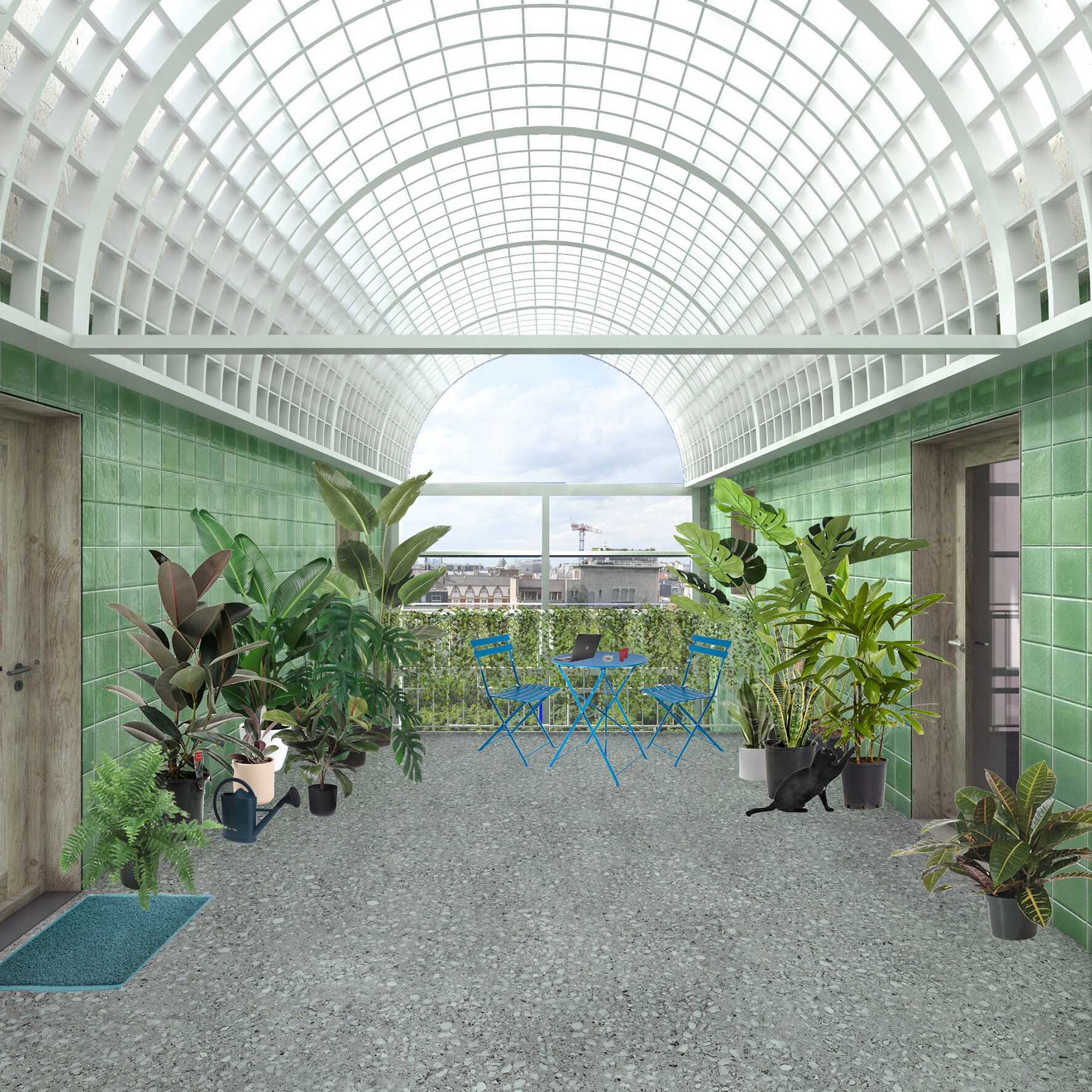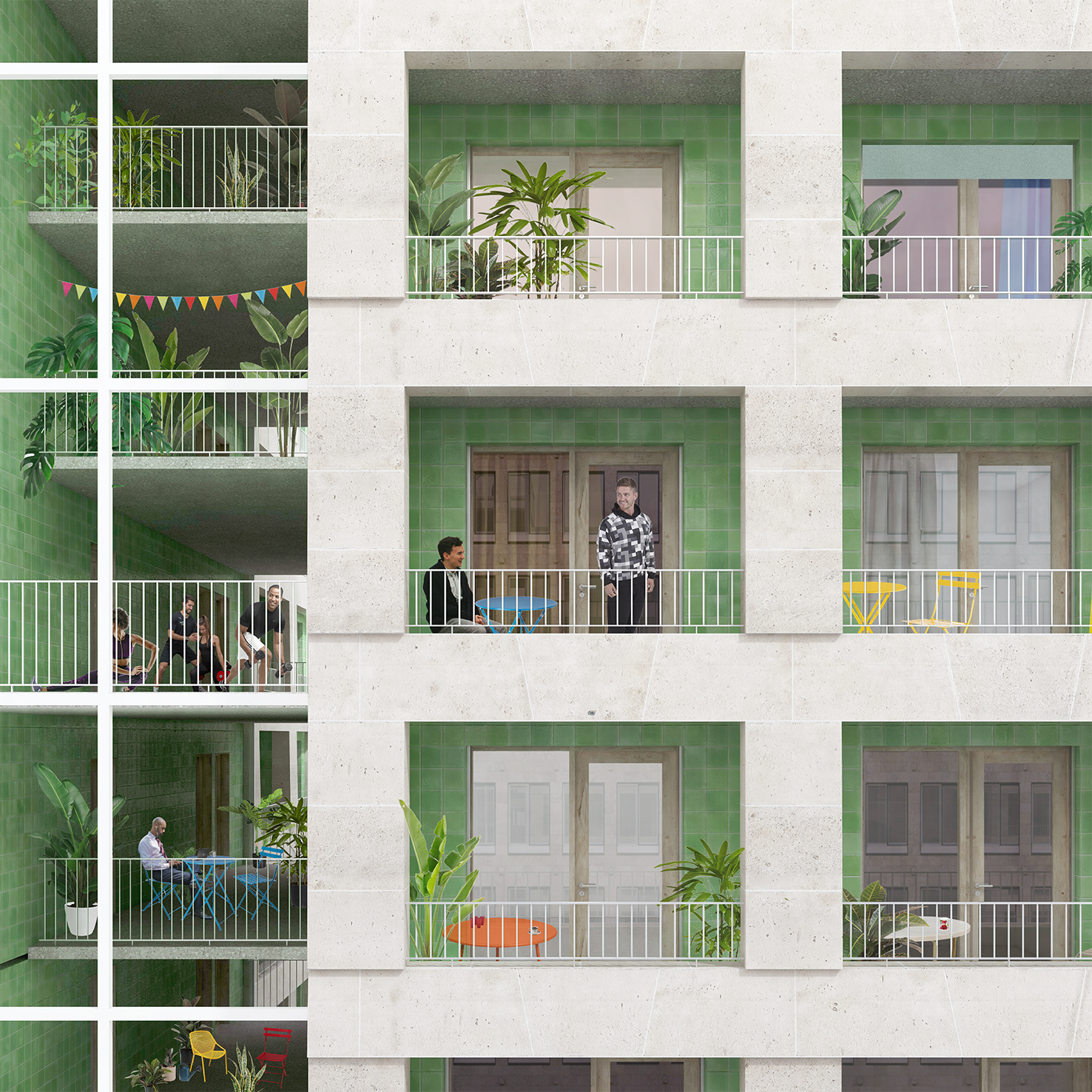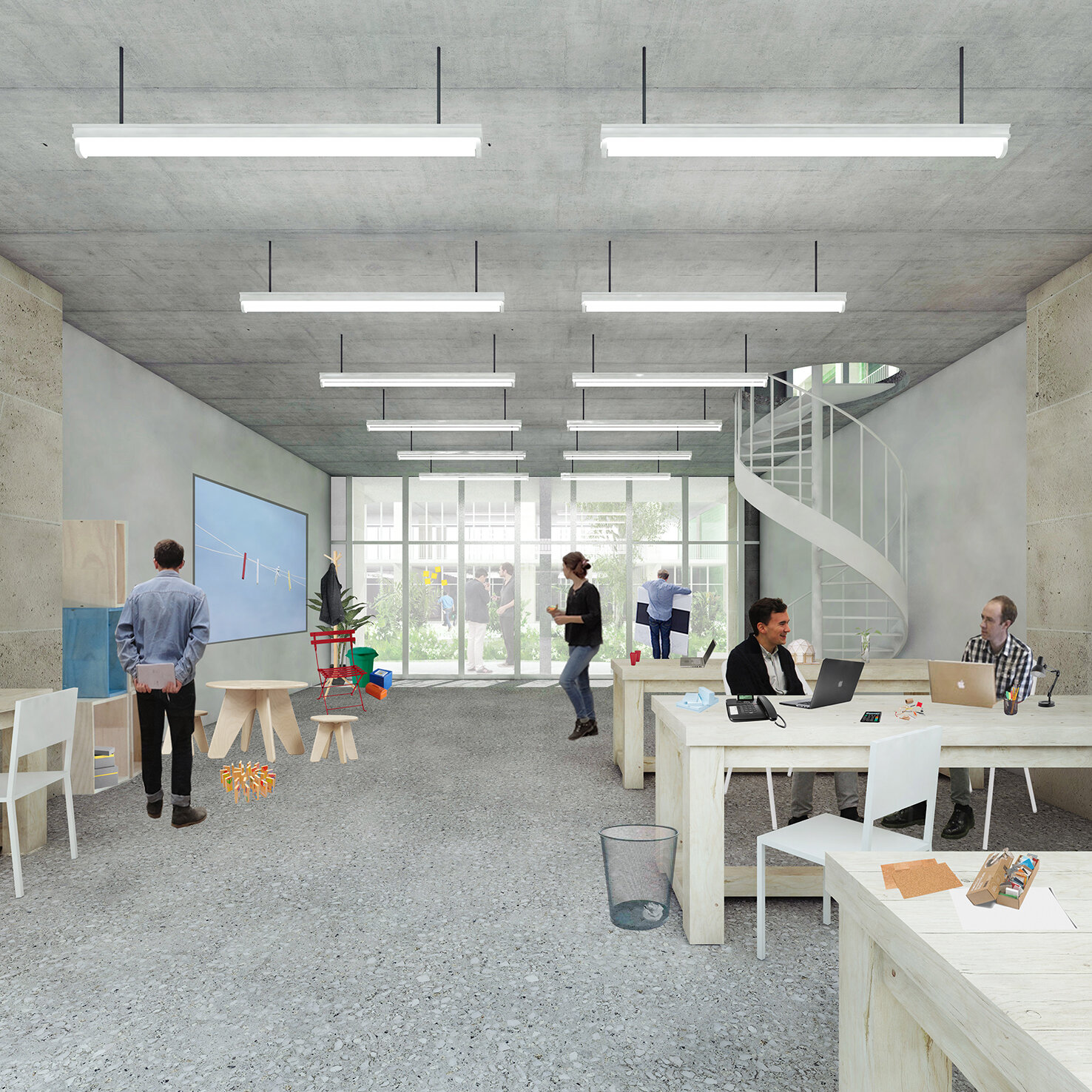Lot PETIT - Saint-Vincent-de-Paul | PETIT Plot in Saint-Vincent de Paul
Construction de 183 logements sociaux et de locaux d’activité en pierre massive | Construction of 183 social housing appartements and productive spaces in massive stone
2019 | Paris, France | 13.140 sqm | Competition – 1st Prize | Commissioner: RIVP (Régie Immobilière de la Ville de Paris) | Team : Kuehn Malvezzi + Plan Común + Nicolas Dorval Bory | Collaborator: Alessandro Nicolai | Consultants : VOGT, Bollinger Grohmann, Inex, Bmf and Lab Ingenierie | Exterior Images : Jeudi Wang
EN - This project is the result of an equal collaborative effort and intense dialogue between the different team members, motivated by a common aim: to find an appropriate strategy, from a volumetric and construction point of view, to resolve the high urban density required while increasing the amount of space available for collective use. Thus, we advocate for a coherent urban structure that provides a framework for the renewed life of Saint-Vincent-de-Paul, while also taking advantage of existing conditions of the site.
The renewed district of ZAC Saint-Vincent-de-Paul will be a predominantly residential area, open to the city and focused on diversity and collective use. Within this context, the project for the Le Petit plot is driven by the following fundamental concerns:
1. Integration of the new buildings into a complex urban fabric with a decisively collective recent history
2. A reflection on housing and cohabitation, on the role of collectives, on shared spaces within the houses as well as the larger urban scale
3. The capacity of the architecture to respond to needs that evolve over time, to adapt to different ways of life
4. The search for architecture capable of responding to the environmental challenges of our time, in particular through a significant economy of means, the conscious use of resources and, beyond that, the need to do more with less
5. The strengthening of biodiversity through a precise and attentive approach, encouraging evapotranspiration as well as the retention and filtration of rainwater
6. To create a coherent strategy in terms of urban, architectural and landscape design in dealing with the place as found, its identity and its shared public spaces – the commons – that could easily be appropriated by different users
Density. The history of the site of the former Saint-Vincent-de-Paul Hospital has been marked by the oscillation between two constants that define its character: composition and efficiency. Over the centuries, this dialectic has produced a rich and varied enclave, where each element is both elegant and efficient. With the arrival of the ‘Grands Voisins’ neighborhood project, the site has demonstrated the exemplary flexibility of its structure.
The place was revitalized by its new uses in both subtle and radical ways.
The building morphology is a hybrid between the urban block and detached buildings: it consists of five volumes that emerge from a shared base. The strategy of subdividing the volumes by means of vertical cut-outs is useful to balance the density, encourage daylight and natural ventilation, and offer different views through the block.
Local tradition. The project is conceived as a contemporary reinterpretation of typical Parisian building methods. It draws on the lessons learnt from emblematic historical examples such as the Cité Napoléon with its generous common spaces topped with a glass roof, and the use of stone in Fernand Pouillon's large-scale housing projects. The project links these different qualities in a system that integrates load-bearing stone facades with an internal wooden structure. The stone facade acts as an exoskeleton in which an insulated and ceramic-clad wood-frame construction is inserted. The regularity and construction principle of the facades allows for a maximum amount of natural light, views from the apartments and for the development of generous and perennial private or shared loggias.
Vertical commons. The vertical cut-outs that structure the block accommodate access and connect the five buildings: they are complementary spaces that offer room for the collective life of the inhabitants and act as buffer zones between the apartments. The vertical in-between spaces accommodate the open terraces. They create in-between spaces that offer additional views, multiply the light and ventilation in the dwellings. The four neighborhood units are organized around these spaces which, partially doubled in height, are designed as living spaces that residents can appropriate.
Human scale. The base of the buildings is the space of synergy between the different programs, a lively place of encounter for inhabitants, users of the activity spaces and passers-by, in direct connection to the public space. The access to the courtyard of the block from the central garden of the ZAC is both monumental and haptic: large limestone pillars merge and coexist with the naturalist landscape and topography. Here, the sunken courtyard is redesigned as a threshold space that extends the urban ground towards the center of the block, forming a generous space at the garden level: a continuous terrain to circulate, accommodate activities, promote biodiversity and retain rainwater. Thus, the project offers spaces of different scales, proportions and attributes to be specifically appropriated: the urban grove in the courtyard, the vertical in-betweens and the different shared roof terraces, all in connection with the landscape around Saint-Vincent-de-Paul.
FR - Ce projet est le résultat d’une collaboration horizontale et d’un dialogue intense entre les différents membres de l’équipe, motivés par une volonté commune : trouver une stratégie appropriée d’un point de vue volumétrique et constructif pour gérer la forte densité demandée, avec notamment une prolifération d’espaces collectifs à différents niveaux. Ainsi, nous plaidons pour un dispositif urbain cohérent et hautement performatif qui serve de cadre à la vie renouvelée de Saint-Vincent-de-Paul, tout en tirant parti des conditions existantes.
Dans le nouveau quartier de la ZAC Saint-Vincent-de-Paul, à dominante résidentielle, ouvert sur la ville, favorisant la mixité et les usages collectifs, ce projet est porteur de thématiques fondamentales :
1. L’insertion dans un tissu urbain complexe et porteur d’une histoire récente résolument collective ;
2. Une réflexion sur les manières d’habiter et de cohabiter, sur la place du collectif, des espaces partagés dans les logements et dans la ville ;
3. La capacité de répondre à des besoins qui évoluent dans le temps, de s’adapter aux différents modes de vie ;
4. La recherche d’une architecture capable de répondre aux enjeux environnementaux de notre temps, notamment par une grande économie de moyens, consciente des ressources et, au-delà, la nécessité de faire plus avec moins.
5. Participer au renforcement de la biodiversité par une démarche à la fois précise et attentive en favorisant l’évapotranspiration, la rétention et l’infiltration des eaux de pluie.
6. La cohérence urbaine, architecturale et paysagère, avec l’existant, l’identité du lieu et ses espaces publics, partagés -les communs- facilement appropriables par les différents usagers.
Densité. L’histoire du site de l’ancien hôpital Saint-Vincent-de-Paul a été marqué par l’oscillation entre deux constantes qui définissent son caractère : composition et efficacité. Cette dialectique produit au fil des siècles une enclave riche et variée, où chaque élément est une pièce à la fois élégante et efficace. Avec l’arrivée des Grands Voisins, le site démontre l’exemplaire flexibilité de sa structure. Le lieu est ranimé par ses nouveaux usages, de manière à la fois subtile et radicale. Ainsi, nous proposons un dispositif urbain cohérent et hautement performatif qui sert de cadre à la vie renouvelée de Saint-Vincent-de-Paul, tout en tirant parti des conditions existantes du site. La morphologie du bâtiment est un hybride entre un bâtiment-îlot et des plots indépendants: elle est constituée de cinq volumes qui émergent d’un socle commun. La stratégie d’épannelage et de subdivision des volumes par des découpes verticales permet d’équilibrer la densité, de favoriser l’ensoleillement et la ventilation naturelle, et d’ouvrir les angles de l’îlot.
Tradition locale. Le projet est conçu comme une réinterprétation contemporaine des modes constructifs typiques parisiens. Pour ce faire, il met à profit les leçons tirées d’exemples historiques emblématiques comme la Cité Napoléon avec ses espaces communs généreux surmontés d’une verrière et l’utilisation de la pierre dans des projets de logements à grande échelle de Fernand Pouillon. Le projet met en relation ces différents attributs dans un système qui inclut des façades portantes en pierre associées à une structure interne en bois. La façade portante en pierre est un exosquelette associé à un remplissage en ossature bois isolé et revêtu de céramique. La régularité et le principe constructif des façades permettent de maximiser la lumière naturelle et les vues dans les logements et d’aménager des loggias privatives ou partagées, à la fois généreuses et pérennes.
Communs verticaux. Les découpes verticales qui structurent l’îlot accueillent les accès et connexions de ces cinq bâtiments : des espaces complémentaires qui offrent de la place pour la vie collective des habitants et agissent comme des espaces de respiration entre les logements. Les failles verticales accueillent les paliers ouverts. Elles créent un espace de transition tout en offrant des vues secondaires, multipliant les apports de lumière et la ventilation dans les logements. Les quatre unités de voisinage s’organisent autour de ces failles. Ces espaces, partiellement en double hauteur, sont conçus comme des lieux de vie capables que les habitants peuvent s’approprier.
Échelle humaine. Le socle est l’espace de synergie entre les différents programmes, un lieu de vie et de rencontre pour les habitants, les usagers des locaux d’activités et les passants, en lien direct avec l’espace public. L’accès au coeur d’îlot depuis le jardin central de la ZAC est à la fois monumental et haptique: les grands piliers en pierre calcaire émergent et cohabitent avec le paysage naturaliste et la topographie du socle. Le dispositif de cour anglaise est ici repensé comme un espace de seuil qui prolonge le sol urbain vers le coeur d’îlot, formant un espace généreux au rez-de-jardin: un sol continu pour circuler, accueillir des activités, favoriser la biodiversité et retenir les eaux pluviales. Ainsi, le projet offre des espaces en plus de différentes échelles, proportions et attributs pour être appropriés de manière spécifique : le bosquet urbain en coeur d’îlot, les entre-deux verticaux et les différentes toitures partagées, tous en connexion avec le paysage alentour de Saint-Vincent-de-Paul.

